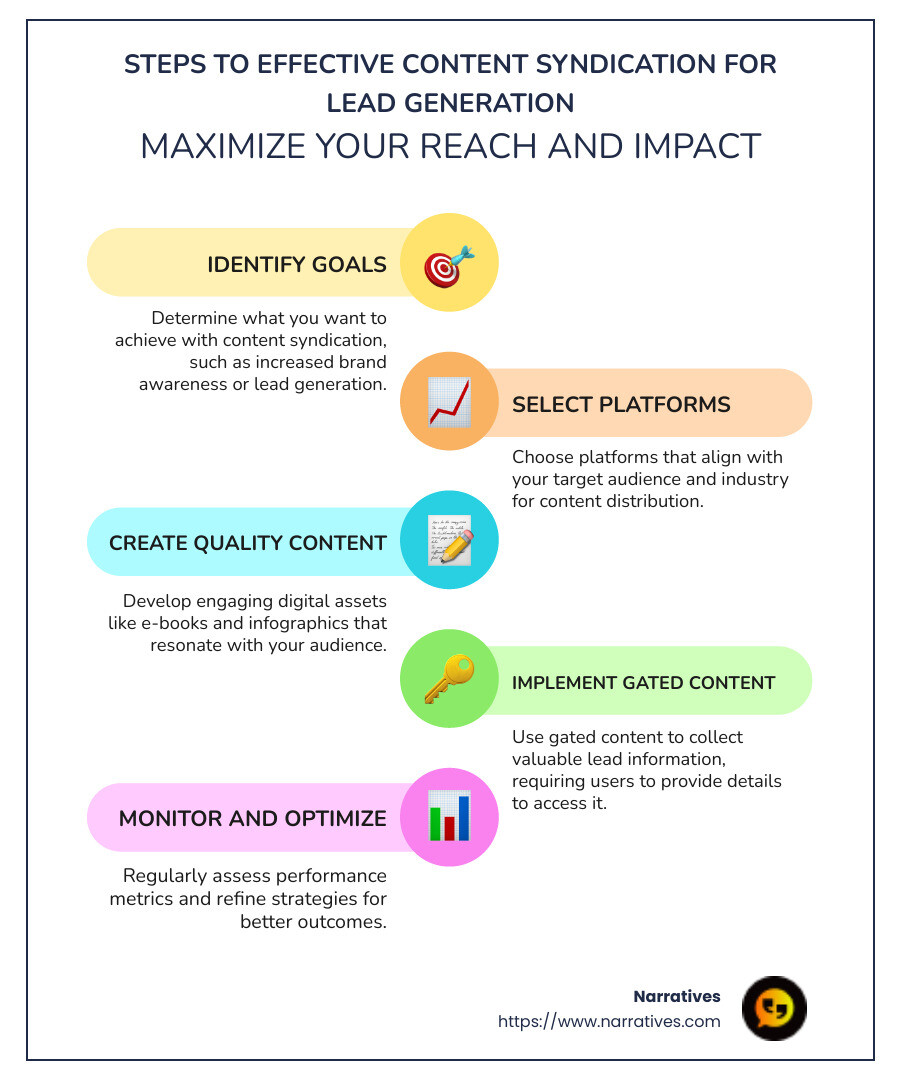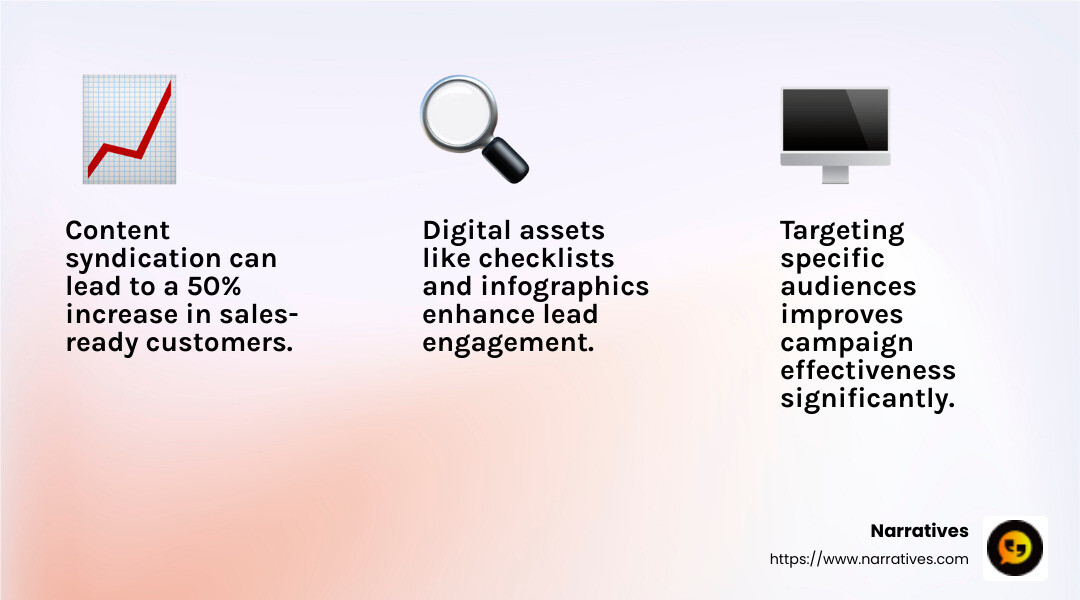From Content to Clients: Syndication Strategies for Lead Generation

Using the Power of Content Syndication for Lead Generation
Content syndication for lead generation is a game-changer for organizations looking to amplify their reach and connect with target audiences. Here's what you need to know to get started right away:
- What is it? It's the process of distributing your digital content, like videos, e-books, or infographics, across multiple platforms to reach a broader audience.
- Why use it? It increases content visibility and attracts quality leads by placing your work where your audience already is.
- How does it work? Partner with content platforms that cater to your niche and require an exchange of information for access to your content. This helps build your lead database.
- What content works best? E-books, whitepapers, infographics, and videos are top choices.
- What are the key benefits? Improved brand awareness and a steady flow of potential leads for nurturing.
For non-profits and values-driven projects, effective content syndication is about more than just visibility. It's about authentic storytelling that resonates deeply and moves communities toward positive action. All of this can directly lead to increased support and engagement.
So, are you ready to unfold the next chapter in your outreach strategy?

Simple content syndication for lead generation word guide:
Understanding Content Syndication for Lead Generation
In the digital marketing world, content syndication for lead generation is a powerful strategy to expand your reach and attract potential clients. Think of it as sharing your well-crafted content, like e-books or videos, on platforms where your audience hangs out. This not only boosts visibility but also draws in quality leads.
What is Content Syndication?
Simply put, content syndication is the act of republishing your content across various platforms. It's like giving your content a second life by placing it in front of new eyes on websites, social media, and other digital channels. This isn't just about getting more views; it's about engaging the right people who are interested in what you offer.
How Does It Drive Lead Generation?
When you syndicate content, you're not just spreading information—you're capturing interest. By offering valuable digital assets, such as infographics or whitepapers, you encourage viewers to provide their contact information in exchange for access. This exchange builds your internal database, giving you a pool of leads to nurture over time.
The Role of Digital Assets
Digital assets are the heart of content syndication. These can be anything from engaging videos to informative e-books. The key is to make them easy-to-digest and relevant to your audience. For instance, a compelling infographic can quickly convey complex information in a visually appealing way, making it more likely to be shared and consumed.

Why It's a Game-Changer
Content syndication isn't just about casting a wide net. It's about precision. By choosing the right platforms and tailoring your content, you ensure it reaches those most likely to be interested. This targeted approach means you’re not just generating random traffic; you're attracting potential clients who are genuinely interested in your offerings.
Key Takeaway: Content syndication for lead generation isn't just about spreading content far and wide. It's about strategically placing your digital assets where they will resonate most, helping you build a robust pipeline of leads ready for nurturing.
Ready to dive deeper into the steps for implementing content syndication? Let's explore how to set goals, select publishers, and create compelling digital assets in the next section.
Steps to Implement Content Syndication
Implementing content syndication for lead generation involves several key steps. By following these steps, you can effectively distribute your content, attract quality leads, and ultimately grow your client base.
1. Goal Setting
Before you begin, it's crucial to establish clear goals. What do you want to achieve with your content syndication campaign? Are you looking to increase brand awareness, generate more leads, or perhaps boost sales? Your goals will guide every decision you make during the campaign.
For most marketers, the primary goal is to get more quality leads. This means focusing on attracting potential clients who are genuinely interested in your products or services. By setting specific, measurable goals, you’ll have benchmarks to evaluate your campaign’s success.
2. Publisher Selection
Choosing the right publisher is essential to reaching your target audience. Your publisher should align with your audience's interests and demographics. For example, if you're targeting tech professionals, look for platforms that cater to that group.
According to research, using filters to target specific audiences—such as by location, company size, or job title—can significantly improve your campaign's effectiveness. If you have a list of target accounts, use it to guide your publisher selection.
3. Digital Asset Creation
Your digital assets are the backbone of your content syndication strategy. These assets could be anything from short e-books to whitepapers. The key is to create content that is quick and easy to digest, so your audience will engage with it.
Consider creating a mix of content types, such as:
- Checklists: Simple, actionable items that provide immediate value.
- “X Ways To …” Articles: Engaging and informative, these articles offer practical advice.
- Infographics: Visually appealing and easy to share, infographics convey complex information succinctly.
Your digital assets should be unique and memorable. Use distinctive colors, fonts, and a consistent tone of voice to make your content stand out. This not only improves brand recognition but also encourages sharing and further engagement.

By focusing on these three steps—goal setting, publisher selection, and digital asset creation—you’re well on your way to implementing a successful content syndication strategy. Next, we’ll dig into best practices for effective content syndication to ensure your efforts yield the best possible results.
Best Practices for Effective Content Syndication
To make the most out of content syndication for lead generation, follow these best practices. They help ensure your content reaches the right audience and converts effectively.
Gated Content
Gated content plays a crucial role in content syndication. This type of content requires users to provide their contact information before accessing it. Why? Because it helps you gather valuable leads who are genuinely interested in what you offer.
Some of the top-performing gated assets include:
- E-books
- Whitepapers
- Infographics
- Videos
- Webinars
These formats offer depth and value, making them more appealing to your audience. When people are willing to exchange their information for your content, it indicates a higher level of interest and intent.
Niche Platforms
Choosing the right platform is essential. Don't just go for mass-market syndication networks. Instead, opt for niche platforms that align with your business and audience.
For example, if you're in the tech industry, look for platforms that specialize in technology content. These platforms understand the specific challenges and interests of your target audience. This alignment ensures that your content is more likely to be seen by those who will appreciate and engage with it.
Audience Filters
Using audience filters is another effective way to target the right people. Filters can include criteria such as job titles, industries, and locations. By setting these parameters, you can focus your efforts on reaching your ideal customer profile.
For instance, if you're targeting IT managers in North America, use filters to exclude audiences that don't fit this profile. This ensures that your content is seen by those most likely to become potential clients, maximizing your return on investment.
By incorporating gated content, selecting niche platforms, and applying audience filters, you can significantly improve the effectiveness of your content syndication strategy. This targeted approach helps ensure that your content not only reaches more people but also attracts the right kind of attention.
Next, we'll explore how to measure success in content syndication, focusing on lead nurturing, CRM integration, and performance metrics.
Measuring Success in Content Syndication
Once you've launched your content syndication for lead generation campaign, it's crucial to measure its success. This helps you understand what's working and what needs improvement. Let’s dive into the key areas: lead nurturing, CRM integration, and performance metrics.
Lead Nurturing
Lead nurturing is the backbone of converting leads into loyal customers. According to research, nurtured leads make 47% larger purchases than non-nurtured ones. So, don't overlook this step.
Email Drip Campaigns: These automated emails keep your brand top-of-mind. They gradually introduce more information, helping leads move through the buyer's journey.
Personalized Content: Use data to tailor content. With 72% of consumers engaging only with personalized messages, this is a must.
Consistent Follow-up: Regular touchpoints build trust. Whether through email, social media, or direct contact, consistency is key.
CRM Integration
Integrating your Customer Relationship Management (CRM) system with your content syndication efforts is essential. This allows you to track and manage leads effectively.
Lead Scoring: Assign scores to leads based on their engagement level. This helps prioritize who your sales team should focus on.
Data Cleansing: Regularly update your CRM to remove outdated or incorrect information. Over 70% of B2B sellers struggle with expired data, so keeping it clean is vital.
Automated Workflows: Use automation to streamline tasks. This frees up your team to focus on high-value activities.
Performance Metrics
Understanding how your content is performing helps refine your strategy. Here are some key metrics to track:
Conversion Rate: Measure how many leads turn into customers. This is a direct indicator of your content's effectiveness.
Cost Per Lead (CPL): Know how much you're spending to acquire each lead. Aim for a balance between cost and lead quality.
Engagement Metrics: Track clicks, views, and shares. These show how well your content resonates with the audience.
By focusing on lead nurturing, CRM integration, and performance metrics, you can gauge the success of your content syndication efforts. This data-driven approach ensures you're not just generating leads but converting them into valuable customers.
Next, we'll tackle some frequently asked questions about content syndication for lead generation, addressing common concerns and clarifying key concepts.
Frequently Asked Questions about Content Syndication for Lead Generation
What is content syndication for lead generation?
Content syndication for lead generation involves republishing your digital assets, like e-books or whitepapers, on other platforms to reach a broader audience. The goal is not just to spread awareness but to actively generate leads. When people access your content, they often provide their contact information in return, helping you build a list of potential customers.
"Content syndication is more than just raising awareness; it's about actively generating leads." - ActualTech Media
This approach allows you to tap into new audiences while collecting valuable data for future nurturing. It's a win-win: you expand your reach and simultaneously gather leads ready for nurturing.
How does content syndication impact SEO?
A common concern is whether content syndication will hurt your SEO efforts. The good news is that it doesn't have to. Google typically showcases the most relevant version of content in search results. You can also ask the host site not to index the syndicated content, ensuring your original content remains the primary search result.
"Content syndication doesn’t hurt your SEO strategy. Google will often pull the most relevant version of your content for consumer search results." - ActualTech Media
By following these guidelines, you can enjoy the benefits of syndication without compromising your search engine rankings.
What types of content work best for syndication?
Not all content is created equal when it comes to syndication. The most effective types include:
- E-books and Whitepapers: These provide in-depth insights and are highly valued by B2B audiences.
- Infographics: Visual content is engaging and easy to digest, making it perfect for sharing.
- Videos: With their ability to convey complex information quickly, videos are a popular choice for engaging audiences.
"Evergreen content such as comprehensive guides, in-depth industry analyses or thought leadership pieces can provide valuable insights for your audience." - Inbox Insight’s B2B tech buyers research
Choosing the right type of content ensures that it resonates with your audience and meets their needs, ultimately driving more qualified leads.
Now that we've covered these frequently asked questions, let's move on to exploring the conclusion of our guide, focusing on how Narratives and storytelling can improve your content syndication strategy.
Conclusion
In today's digital landscape, content syndication for lead generation is a powerful strategy, especially for non-profits and purpose-driven organizations. By sharing your stories through syndication, you can reach broader audiences, generate leads, and amplify your impact.
At Narratives, we understand the unique challenges faced by non-profits. Our mission is to lift underrepresented voices through compelling storytelling. By focusing on high-quality, emotionally resonant video and multimedia content, we help organizations share their impact stories in ways that inspire action, build trust, and increase visibility.
Storytelling is at the heart of effective content syndication. It’s not just about distributing content; it’s about connecting with your audience on a deeper level. When you tell a story that resonates, you create a memorable experience that sticks with your audience long after they’ve engaged with your content.
For non-profits, this approach is invaluable. Partnering with a syndication service like Narratives allows you to showcase your mission and the communities you serve. By doing so, you not only generate leads but also foster meaningful relationships with supporters and stakeholders.
In conclusion, content syndication is more than a marketing tactic—it's a way to share your story with the world. By leveraging the power of storytelling and strategic partnerships, non-profits can expand their reach and make a lasting impact.
To learn more about how Narratives can support your content syndication efforts and help you tell your story, explore our services here. Let's work together to lift your mission and connect with those who matter most.


